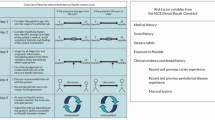Abstract
Design
Randomised controlled trial
Intervention
All patients received treatment to render them dentally fit. Patients were randomly allocated to either the removable dental prostheses (RPD) or the shortened dental arch (SDA) group. Patients in the RDP group were restored to complete arches with RDP using cobalt-chromium frameworks according to a standardised protocol. For the SDA group, patients were restored to a shortened arch of ten occluding pairs of natural and replacement teeth using resin-bonded bridgework (RBB).
Outcome measure
Treatment effect was measured using the change in oral health-related quality of life (OHrQOL). For each patient the costs of delivering treatment were recorded by a research nurse during the intervention period. Laboratory costs were recorded as part of normal hospital policy for all patients. All of the dental materials used were recorded and given a unit price. The cost of professional time per patient was estimated using the highest point of the salary scale for the Community Dental Service in Ireland.
Results
One hundred and thirty-two patients were randomised; 65 to the RPD group and 67 to the SDA group. Ninety-two patients (69.7%) completed the study (46 in RPD group; 46in SDA group). There was no difference in the success rates of the two treatments over the period. Five pieces of resin-bonded bridgework (RBB) debonded and were recemented over the 12-month period giving a success rate of 95.5% for the RBB. Four patients discontinued wearing their RPDs; all four RPDS were fitted in the lower arch and included bilateral free end saddles, a success rate of 95.9%. Both RPD and SDA groups demonstrated statistically significant improvements in OHrQoL scores after 12 months.
The total cost of achieving the minimally important clinical difference (MID) in OHrQOL for an average patient in the RDP group was €464.64. For the SDA group, the cost of achieving the MID for an average patient was €252.00. The cost-effectiveness ratio was therefore 1:1.84 in favour of SDA treatment.
Conclusions
With an increasingly ageing population, many patients will continue to benefit from removable prostheses to replace their missing natural teeth. From a purely economic standpoint, the results from this analysis suggest that the treatment of partially dentate older adults should be focused on functionally orientated treatment because it is simply more cost-effective.
Similar content being viewed by others
Log in or create a free account to read this content
Gain free access to this article, as well as selected content from this journal and more on nature.com
or
References
O'Sullivan I, Lader D, Beavan-Seymour C, Chenery V, Fuller E, Sadler K . 2011. Foundation report: Adult Dental Health Survey 2009 (Technical information). http://www.hscic.gov.uk/pubs/dentalsurveyfullreport09. [Accessed 9th March 2015]
Locker D, Jokovic A, Clarke M . Assessing the responsiveness of measures of oral health-related quality of life. Community Dent Oral Epidemiol 2004; 32: 10–18
Author information
Authors and Affiliations
Additional information
Address for correspondence: Gerald McKenna, Lecturer in Prosthodontics and Oral Rehabilitation, Cork University Dental School and Hospital, University College Cork, Cork, Ireland. E-mail: g.mckenna@ucc.ie
McKenna G, Allen F, Woods N, O'Mahony D, Cronin M, DaMata C, Normand C. Cost-effectiveness of tooth replacement strategies for partially dentate elderly: a randomized controlled clinical trial. Community Dent Oral Epidemiol 2014; 42: 366–374. doi: 10.1111/cdoe.12085. Epub 2013 Nov 20. PubMed PMID: 24251386.
Rights and permissions
About this article
Cite this article
Levey, C., Dunbar, C. Shortened dental arch concept shown to be cost effective. Evid Based Dent 16, 19–20 (2015). https://doi.org/10.1038/sj.ebd.6401080
Published:
Issue date:
DOI: https://doi.org/10.1038/sj.ebd.6401080



